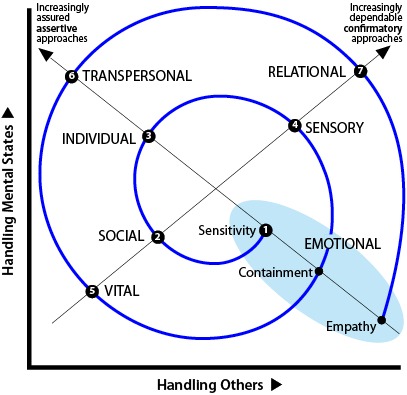Principles that Generate a Spiral
Methods to Modes
Remember: In any Spiral analysis, the methods are content
prescriptions and the modes are their contextual values.
Use of the spontaneously generates a . A person is only fully comfortable in using one or two and depends on these for effective daily functioning.
However, all of the contain widely accepted assumptions and values. These form the basis for a corresponding .
generates and sustains inner convictions and the resultant grows stronger with the cumulative establishment of each This process is mapped as a Spiral trajectory on the TET, and the re-order the .![]() See Re-ordering Table:
See Re-ordering Table:
Construction of a Spiral
The necessarily commences in an with an accompanying inner assertion of immediate feelings.

These feelings are claimed as 'mine' and seem to be located 'inside me', and so create a sense of "me" automatically. This emergent is not complex or sophisticated or even sustained. Indeed, there can be no inner concept of «a self» because emotions are so variable, diffuse and changeable.
To sustain and strengthen this primordial and unavoidable degree of , additional must be activated in a series of In the TET diagram, the natural order of for strengthening generates a Spiral trajectory as shown at right.
To analyse «», we must identify those phenomena crucial to sustaining a person's effective functioning within a social setting.
Each is built around:
a) promoting well-being (the psychosocial pressure) by:
- the essence necessary for well-being in that Stage;
- the desired effect that is experienced as well-being;
- the means whereby that effect and consequent well-being is enabled.
b) handling the social milieu in terms of:
- the exercise of autonomy in that Stage;
- the approach to participation in that Stage;
- the affirmation of individuality in that Stage.
c) channeling personal functioning to:
- boost self-esteem.
Cumulation & Drivers
With each successive , the values from earlier persist and cumulate with a new set of values.
Because value-sets are cumulated, we can distinguish between the and the emergent in any : e.g. versus . The refers to the specific new value-set at that Stage; and the refers to dominance of the newest Mode while explicitly including all previous Modes.
Each transition has its stresses. So a person will find themselves settling at the where the feels sufficiently strong and satisfactory.
The drivers for progression through the modes include:
- need for a more valued and coherent sense of self
- wish to overcome limitations and vulnerabilities of the current Stage
- pressures from internal or external sources (e.g. ageing, family, peers)
- excessive or distorted use of the current mode.
During the maturational process, a person's self moves from being labile-transient to becoming stable and then maximally resilient. From an emotional perspective, a person moves from a volatile sensitivity, to being contained, and finally to consistent empathy.
Note: As usual, features of higher may be activated at any Stage as part of ensuring sufficient , but that does not mean to that .
-
See a summary preview.
- Start in Stage-1: Emotional Sensitivity.
Originally drafted: 4-Jan-2016. Last amended: 20-Jun-2016.